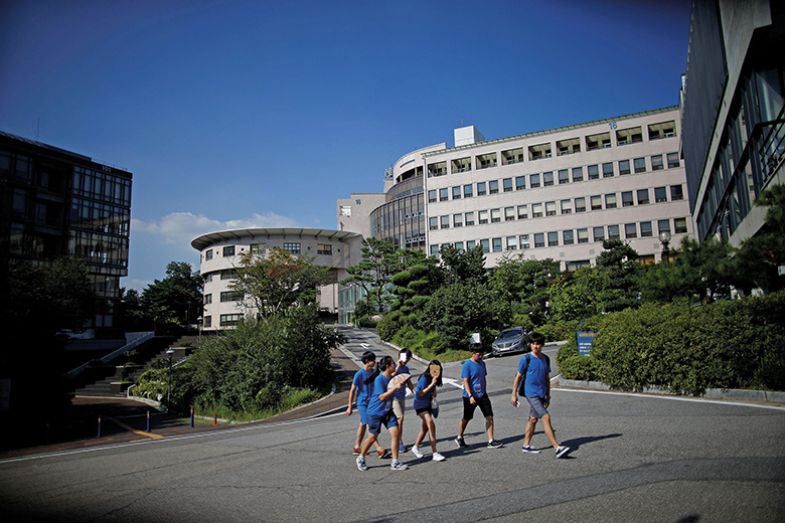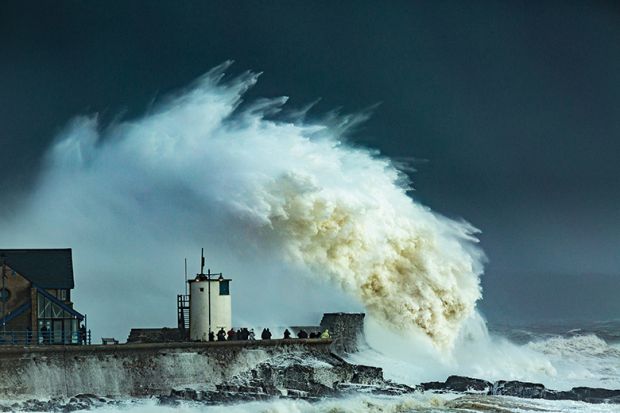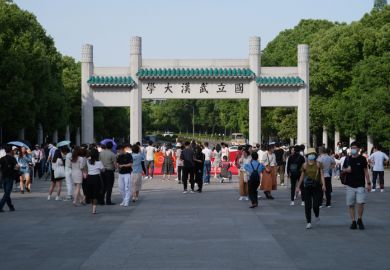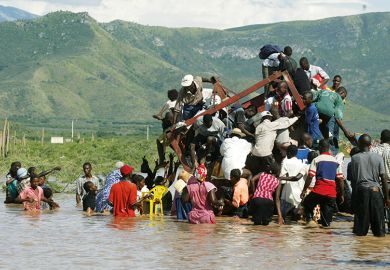Browse the full results of the World University Rankings 2022
Download a copy of the World University Rankings 2022 report
If anyone is in doubt that higher education is at a pivotal moment, Brian Schmidt is here to set the record straight.
“We will see institutions make very poor long-term decisions in the heat of this short-term crisis. And we will see, on the other side, people make really profound long-term decisions which will reward them greatly in the future,” the Australian National University vice-chancellor says about how leaders will continue to navigate their institutions during and after the Covid-19 pandemic.
“I wish I knew exactly what were the really profoundly smart things to do right now, but some institutions will do those and they will emerge at the end of this much better off than they were beforehand,” he adds.
One of the poor decisions he is most concerned about is universities separating teaching from research and then cross-subsidising research with the profits from teaching or other income – a trend he has long worried about but fears will become even more common as a result of the coronavirus crisis.
“People are stressed; they’re trying to figure out ways to save money and fixes that are quick and not long term,” he says. “We have to be very careful not to chase a short-term thing for financial reasons that in the long term, when you think about it, makes no sense at all.”
Schmidt paints the separation of teaching and research as an existential threat, saying that as soon as universities “go down the path of subsidising one activity with another, someone else is going to cut your grass eventually and do it without that extra tax in the middle and probably do it better than you”.
“We’re going to be very careful about how we keep the research university going” at ANU, which is ranked joint 54th in the 2022 Times Higher Education World University Rankings, up from 59th last year.
“If you’re a university that only focuses on teaching, that’s fine. But when you pretend to be both [a teaching and research university] and be neither, that’s very dangerous territory. I could easily see many universities getting themselves into a world of hurt there…I see that as a place where they could easily be disintermediated by other players coming in and doing either better.”
Another big risk for universities, particularly those in Australia, that also relates to cross-subsidisation is the future of the international student market. Australia’s international borders have been closed for 18 months, although small numbers of overseas students have gained entry.
For Schmidt, the jury is still out on whether the number of international students in Australia will ever return to pre-pandemic levels. But either way, he thinks the recovery process will be “harder than people want it to be” because there is more competition from other nations as well as geopolitical tensions and financial challenges that mean some prospective students are no longer able to fund international study.
“I could see things going anywhere from a complete bust-up of the international market to going back to close to normal to anywhere in between. It is completely open right now,” he says.
“I think everyone wants the old way of doing things because we all were comfortable and most of the public policy problems in Australia were fixed by international students. So I think there’s a naive hope, and almost praying, we will go back to normal.”
Schmidt says ANU’s international student recruitment strategy is focused on providing an excellent student and learning experience rather than providing the institution with a lucrative income stream.
“If I know I do something and it’s excellent for students, I’m betting that’s going to work better for me long term right now, because it’s very uncertain going forward, than just trying to maximise revenue,” he says.
However, there is no question that the money factor is an issue given that education and research in Australia are heavily financed from international student fees.
Is there a potential model where there could be a sustained decline in international student numbers but not a decline in research?
“No, I do not think there is a model for that to occur unless the Australian government invests more money in research and development,” Schmidt concedes.
“The government is very keen for us to do more research with industry, and I’m keen. But around the world, you can see how much that is, and it’s all driven by government expenditure and…it just doesn’t add up.
“If we lose international students, the reality is there is no other source of money on the [same] scale, and we’re going to do less research and we’re going to teach our students with less resources.”
But while there has been a lot of change, uncertainty and anxiety in the sector since the start of the pandemic, several leaders say the crisis has also helped to provide clarity about the aspects of higher education that were working well before Covid and on which they should now double down.
“In some sense, the crisis showed the red line between what can be digitised and what cannot,” says Martin Vetterli, president of École Polytechnique Fédérale de Lausanne (EPFL), which is joint 40th in the THE World University Rankings, up from 43rd last year.
“This red line is not totally clear for everything right now; but before it was very fuzzy because we had no idea, and now it has been sharpened by this experiment” of remote working.

Sir Anton Muscatelli, vice-chancellor of the University of Glasgow, joint 86th in the global league table, up from joint 92nd, says the pandemic has made it clear that active learning – which focuses on students interacting with their teachers and peers – must be “even more central” to education at the institution.
Glasgow had begun to accelerate this style of teaching in 2016 by developing spaces on campus to encourage and enhance interaction, in some cases through the use of technology, but Muscatelli says the past 18 months have shown that active learning “cannot be replaced by an online experience”.
Schmidt agrees, saying undergraduate education at ANU will remain centred around on-campus learning.
“We surveyed our students, and 97.5 per cent of them want to be back on campus. So it would be foolish to throw that away,” he says.
However, he sees more opportunity to shake up postgraduate education. While there will continue to be a campus-based programme, “there is real appetite for a largely digital programme”, particularly for those who are already in the workforce and may want to study part-time to “add to their skill set”.
“For us, it’s not about getting rid of humans, it’s about making humans superhuman. Use digital not for efficiency – that is, lowering the cost – but rather increasing the output, making things much, much better than they could otherwise be,” Schmidt says.
Other leaders say the crisis has emphasised the importance of social interactions.
“The campus is a social space, and that we cannot do online,” says Vetterli, highlighting social isolation among students and staff as one of the main issues over the past year and a half.
“If I look at the management level, for example, online meetings are OK for run-of-the-mill stuff, but it doesn’t work for brainstorming, it doesn’t work for open-ended serendipity. These natural interactions – I’m certainly missing them.”
Dukgeun Ahn, dean of international affairs at South Korea’s Seoul National University, ranked joint 54th, up from 60th, says social interaction is particularly important for university students in East Asia because there is little opportunity to learn social skills during school.
However, Ahn continues, there have been some positive changes at the institution as a result of the switch to online learning. For example, moving international summer programmes online allowed the institution to invite foreign faculty to teach some of the courses – something that would have been impossible in previous years when the six-week courses were all face-to-face in Korea. Looking ahead, the plan is for international academics to teach remotely for four to five weeks and then come to campus for the remaining week or two. International students would also be able to join the programme remotely or in-person.
“This current situation caused a lot of trouble for us. But on the other hand, we could come up with this kind of alternative teaching opportunity, and I believe this is a good chance for us to broaden our international education opportunities,” Ahn says.
Meanwhile, in Glasgow, Muscatelli says the university has been able to accelerate and improve the adoption of virtual reality (VR) technology. Previously, each individual student required VR equipment to use in the classroom, but the move to online learning led the institution to partner with a company to develop a way to use VR by proxy. This means that only the teacher has a VR headset and the 3D environment is shared with students via a videoconferencing platform.
“It democratises VR because it means you don’t need lots and lots of equipment,” Muscatelli says. “In many respects, [the crisis has] allowed us to accelerate and adapt new technologies in teaching that previously had a higher entry barrier.”
But EPFL’s Vetterli believes that the move to online working has led to an even more fundamental benefit: it has allowed universities to truly fulfil their role as public-serving institutions.
“When Moocs [massive open online courses] were introduced, people said: ‘We’re finally going to do good for humanity. We have these glitzy campuses that are well funded, with star professors, and now we are finally going to do what we always promised as academics – share this knowledge with the world.’ It didn’t quite happen,” he says.
However, he believes that this shift will now occur thanks to the prevalence of online and hybrid lectures, which can be made available to anyone in the world.
“At EPFL, we are a public university; people are essentially studying for free, I’m paid by taxpayers’ money – I should put this knowledge and know-how out not just to people in the room but to the world,” Vetterli says. “And I think this will happen, thanks to digitalisation, but also because of experiments we have been doing in the last 18 months.”
ellie.bothwell@timeshighereducation.com
Download a copy of the World University Rankings 2022 report
POSTSCRIPT:
Print headline: In the tempest, illumination and apprehension
Register to continue
Why register?
- Registration is free and only takes a moment
- Once registered, you can read 3 articles a month
- Sign up for our newsletter
Subscribe
Or subscribe for unlimited access to:
- Unlimited access to news, views, insights & reviews
- Digital editions
- Digital access to THE’s university and college rankings analysis
Already registered or a current subscriber? Login








